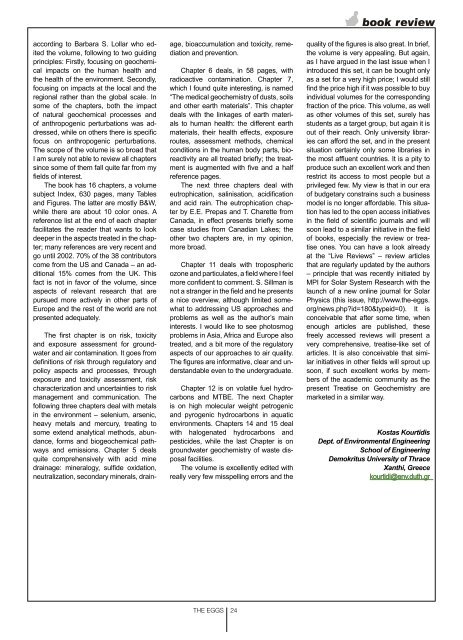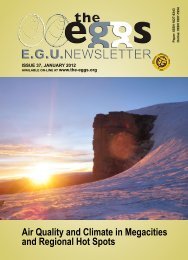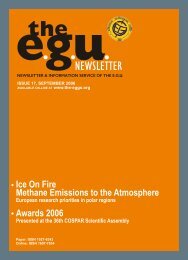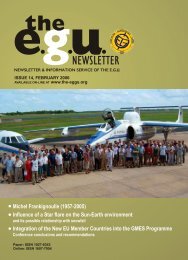Report on the Berlin 2 Open Access Conference - European ...
Report on the Berlin 2 Open Access Conference - European ...
Report on the Berlin 2 Open Access Conference - European ...
You also want an ePaper? Increase the reach of your titles
YUMPU automatically turns print PDFs into web optimized ePapers that Google loves.
according to Barbara S. Lollar who edited<strong>the</strong> volume, following to two guidingprinciples: Firstly, focusing <strong>on</strong> geochemicalimpacts <strong>on</strong> <strong>the</strong> human health and<strong>the</strong> health of <strong>the</strong> envir<strong>on</strong>ment. Sec<strong>on</strong>dly,focusing <strong>on</strong> impacts at <strong>the</strong> local and <strong>the</strong>regi<strong>on</strong>al ra<strong>the</strong>r than <strong>the</strong> global scale. Insome of <strong>the</strong> chapters, both <strong>the</strong> impactof natural geochemical processes andof anthropogenic perturbati<strong>on</strong>s was addressed,while <strong>on</strong> o<strong>the</strong>rs <strong>the</strong>re is specificfocus <strong>on</strong> anthropogenic perturbati<strong>on</strong>s.The scope of <strong>the</strong> volume is so broad thatI am surely not able to review all chapterssince some of <strong>the</strong>m fall quite far from myfields of interest.The book has 16 chapters, a volumesubject Index, 630 pages, many Tablesand Figures. The latter are mostly B&W,while <strong>the</strong>re are about 10 color <strong>on</strong>es. Areference list at <strong>the</strong> end of each chapterfacilitates <strong>the</strong> reader that wants to lookdeeper in <strong>the</strong> aspects treated in <strong>the</strong> chapter;many references are very recent andgo until 2002. 70% of <strong>the</strong> 38 c<strong>on</strong>tributorscome from <strong>the</strong> US and Canada – an additi<strong>on</strong>al15% comes from <strong>the</strong> UK. Thisfact is not in favor of <strong>the</strong> volume, sinceaspects of relevant research that arepursued more actively in o<strong>the</strong>r parts ofEurope and <strong>the</strong> rest of <strong>the</strong> world are notpresented adequately.The first chapter is <strong>on</strong> risk, toxicityand exposure assessment for groundwaterand air c<strong>on</strong>taminati<strong>on</strong>. It goes fromdefiniti<strong>on</strong>s of risk through regulatory andpolicy aspects and processes, throughexposure and toxicity assessment, riskcharacterizati<strong>on</strong> and uncertainties to riskmanagement and communicati<strong>on</strong>. Thefollowing three chapters deal with metalsin <strong>the</strong> envir<strong>on</strong>ment – selenium, arsenic,heavy metals and mercury, treating tosome extend analytical methods, abundance,forms and biogeochemical pathwaysand emissi<strong>on</strong>s. Chapter 5 dealsquite comprehensively with acid minedrainage: mineralogy, sulfide oxidati<strong>on</strong>,neutralizati<strong>on</strong>, sec<strong>on</strong>dary minerals, drainage,bioaccumulati<strong>on</strong> and toxicity, remediati<strong>on</strong>and preventi<strong>on</strong>.Chapter 6 deals, in 58 pages, withradioactive c<strong>on</strong>taminati<strong>on</strong>. Chapter 7,which I found quite interesting, is named“The medical geochemistry of dusts, soilsand o<strong>the</strong>r earth materials”. This chapterdeals with <strong>the</strong> linkages of earth materialsto human health: <strong>the</strong> different earthmaterials, <strong>the</strong>ir health effects, exposureroutes, assessment methods, chemicalc<strong>on</strong>diti<strong>on</strong>s in <strong>the</strong> human body parts, bioreactivityare all treated briefly; <strong>the</strong> treatmentis augmented with five and a halfreference pages.The next three chapters deal wi<strong>the</strong>utrophicati<strong>on</strong>, salinisati<strong>on</strong>, acidificati<strong>on</strong>and acid rain. The eutrophicati<strong>on</strong> chapterby E.E. Prepas and T. Charette fromCanada, in effect presents briefly somecase studies from Canadian Lakes; <strong>the</strong>o<strong>the</strong>r two chapters are, in my opini<strong>on</strong>,more broad.Chapter 11 deals with troposphericoz<strong>on</strong>e and particulates, a field where I feelmore c<strong>on</strong>fident to comment. S. Sillman isnot a stranger in <strong>the</strong> field and he presentsa nice overview, although limited somewhatto addressing US approaches andproblems as well as <strong>the</strong> author’s maininterests. I would like to see photosmogproblems in Asia, Africa and Europe alsotreated, and a bit more of <strong>the</strong> regulatoryaspects of our approaches to air quality.The figures are informative, clear and understandableeven to <strong>the</strong> undergraduate.Chapter 12 is <strong>on</strong> volatile fuel hydrocarb<strong>on</strong>sand MTBE. The next Chapteris <strong>on</strong> high molecular weight petrogenicand pyrogenic hydrocarb<strong>on</strong>s in aquaticenvir<strong>on</strong>ments. Chapters 14 and 15 dealwith halogenated hydrocarb<strong>on</strong>s andpesticides, while <strong>the</strong> last Chapter is <strong>on</strong>groundwater geochemistry of waste disposalfacilities.The volume is excellently edited withreally very few misspelling errors and <strong>the</strong>quality of <strong>the</strong> figures is also great. In brief,<strong>the</strong> volume is very appealing. But again,as I have argued in <strong>the</strong> last issue when Iintroduced this set, it can be bought <strong>on</strong>lyas a set for a very high price; I would stillfind <strong>the</strong> price high if it was possible to buyindividual volumes for <strong>the</strong> corresp<strong>on</strong>dingfracti<strong>on</strong> of <strong>the</strong> price. This volume, as wellas o<strong>the</strong>r volumes of this set, surely hasstudents as a target group, but again it isout of <strong>the</strong>ir reach. Only university librariescan afford <strong>the</strong> set, and in <strong>the</strong> presentsituati<strong>on</strong> certainly <strong>on</strong>ly some libraries in<strong>the</strong> most affluent countries. It is a pity toproduce such an excellent work and <strong>the</strong>nrestrict its access to most people but aprivileged few. My view is that in our eraof budgetary c<strong>on</strong>strains such a businessmodel is no l<strong>on</strong>ger affordable. This situati<strong>on</strong>has led to <strong>the</strong> open access initiativesin <strong>the</strong> field of scientific journals and willso<strong>on</strong> lead to a similar initiative in <strong>the</strong> fieldof books, especially <strong>the</strong> review or treatise<strong>on</strong>es. You can have a look alreadyat <strong>the</strong> “Live Reviews” – review articlesthat are regularly updated by <strong>the</strong> authors– principle that was recently initiated byMPI for Solar System Research with <strong>the</strong>launch of a new <strong>on</strong>line journal for SolarPhysics (this issue, http://www.<strong>the</strong>-eggs.org/news.php?id=180&typeid=0). It isc<strong>on</strong>ceivable that after some time, whenenough articles are published, <strong>the</strong>sefreely accessed reviews will present avery comprehensive, treatise-like set ofarticles. It is also c<strong>on</strong>ceivable that similarinitiatives in o<strong>the</strong>r fields will sprout upso<strong>on</strong>, if such excellent works by membersof <strong>the</strong> academic community as <strong>the</strong>present Treatise <strong>on</strong> Geochemistry aremarketed in a similar way.Kostas KourtidisDept. of Envir<strong>on</strong>mental EngineeringSchool of EngineeringDemokritus University of ThraceXanthi, Greecekourtidi@env.duth.grTHE EGGS 24





